Chapter: Compilers : Principles, Techniques, & Tools : Syntax Analysis
Bottom-Up Parsing
Bottom-Up Parsing
1 Reductions
2 Handle Pruning
3 Shift-Reduce Parsing
4 Conflicts During Shift-Reduce
Parsing
5 Exercises for Section 4.5
A bottom-up parse corresponds to the construction of a parse tree for an
input string beginning at the leaves (the bottom) and working up towards the
root (the top). It is convenient to describe parsing as the process of building
parse trees, although a front end may in fact carry out a translation directly
without building an explicit tree. The sequence of tree snapshots in Fig. 4.25
illustrates

a bottom-up parse of the token stream id * id, with respect to the expression grammar (4.1).
This section introduces a general style of bottom-up parsing known as
shift-reduce parsing. The largest class of grammars for which shift-reduce
parsers can be built, the LR grammars, will be discussed in Sections 4.6 and
4.7. Although it is too much work to build an LR parser by hand, tools called
automatic parser generators make it easy to construct efficient LR parsers from
suitable gram-mars. The concepts in this section are helpful for writing
suitable grammars to make effective use of an LR parser generator. Algorithms
for implementing parser generators appear in Section 4.7.
1. Reductions
We can think of bottom-up parsing as the process of "reducing"
a string w to the start symbol of the grammar. At each reduction step, a specific
substring matching the body of a production is replaced by the nonterminal at
the head of that production.
The key decisions during bottom-up parsing are about when to reduce and
about what production to apply, as the parse proceeds.
Example 4.37 : The snapshots in Fig. 4.25 illustrate a sequence of
reductions; the grammar is the expression grammar (4.1). The reductions will be
discussed in terms of the sequence of strings
id * id, F * i d , T * i d , T*F, T, E
The strings in this sequence are formed from the roots of all the
subtrees in the snapshots. The sequence starts with the input string id*id .
The first reduction produces F*id by reducing the leftmost id to F, Using the
production F ->• id. The second reduction produces T * id by reducing F to
T.
Now, we have a choice between reducing the string T, which is the body
of E -> T, and the string consisting of the second id, which is the body of
F -)• id. Rather than reduce T to E, the second id is reduced to T, resulting
in the string T * F. This string then reduces to T. The parse completes with
the reduction of T to the start symbol E. •
By definition, a reduction is the reverse of a step in a derivation
(recall that in a derivation, a nonterminal in a sentential form is replaced by
the body of one of its productions). The goal of bottom-up parsing is therefore
to construct a derivation in reverse. The following derivation corresponds to
the parse in Fig. 4.25:
E => T =>• T * F T * id => F * id i d * id
This derivation is in fact a rightmost derivation.
2. Handle Pruning
Bottom-up parsing during a left-to-right scan of the input constructs a
rightmost derivation in reverse. Informally, a "handle" is a
substring that matches the body of a production, and whose reduction represents
one step along the reverse of a rightmost derivation.
For example, adding subscripts to the tokens id for clarity, the handles during the parse of idi * i d 2 according to the expression grammar (4.1) are as in Fig. 4.26. Although T is the body of the production E -» T, the symbol T is not a handle i n the sentential form T * id 2 . I f T were indeed replaced b y E , we would get the string E * i d 2 , which cannot be derived from the start symbol E. Thus, the leftmost substring that matches the body of some production need not be a handle.

Notice that the string w to
the right of the handle must contain only terminal symbols. For convenience, we
refer to the body b rather than A -> b as a handle. Note we say "a handle" rather than
"the handle," because the grammar could be ambiguous, with more than
one rightmost derivation of abw. If
a grammar is unambiguous, then every right-sentential form of the grammar has
exactly one handle.
A rightmost derivation in reverse can be obtained by "handle
pruning." That is, we start with a string of terminals w to be parsed. If ID is a sentence
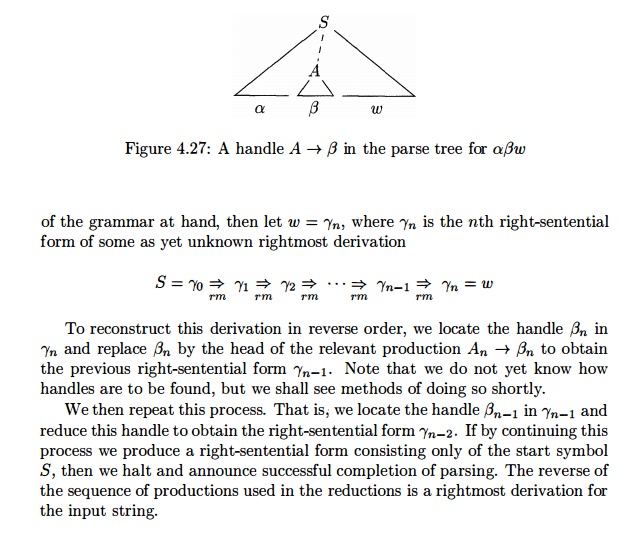
3. Shift-Reduce Parsing
Shift-reduce parsing is a form of bottom-up parsing in which a stack
holds grammar symbols and an input buffer holds the rest of the string to be
parsed.
As we
shall see, the handle always appears at the top of the stack just before it is
identified as the handle.
We use $ to mark the bottom of the stack and also the right end of the
input. Conventionally, when discussing bottom-up parsing, we show the top of
the stack on the right, rather than on the left as we did for top-down parsing.
Initially, the stack is empty, and the string w is on the input, as follows:

During a left-to-right scan of the input string, the parser shifts zero
or more input symbols onto the stack, until it is ready to reduce a string /3 of grammar symbols on top of the
stack. It then reduces (3 to the head
of the appropriate production. The parser repeats this cycle until it has
detected an error or until the stack contains the start symbol and the input is
empty:

Upon entering this configuration, the parser halts and announces
successful completion of parsing. Figure 4.28 steps through the actions a
shift-reduce parser might take in parsing the input string idi *icl2 according
to the expression grammar (4.1).
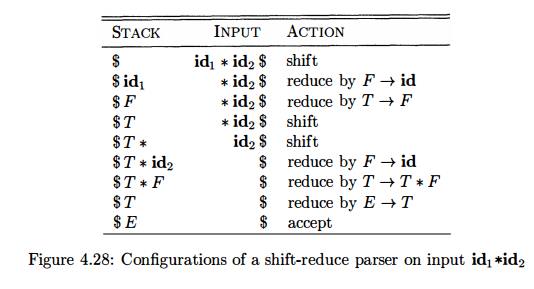
While the primary operations are shift and reduce, there are actually
four possible actions a shift-reduce parser can make: (1) shift, (2) reduce,
(3) accept, and (4) error.
1. Shift. Shift the next input symbol onto the top of the stack.
2. Reduce. The right
end of the string to be reduced must be at the top of the stack. Locate the left end of the string within the
stack and decide with what nonterminal to replace the string.
Accept. Announce successful completion of parsing.
Error. Discover a syntax error and call an error
recovery routine.
The use of a stack in shift-reduce parsing is justified by an important
fact: the handle will always eventually appear on top of the stack, never
inside. This fact can be shown by considering the possible forms of two
successive steps in any rightmost derivation. Figure 4.29 illustrates the two
possible cases. In case (1), A is replaced by (3By, and then the rightmost nonterminal
B in the body (3By is replaced by 7. In case (2), A is again expanded first,
but this time the body is a string y of terminals only. The next rightmost nonterminal B will be
somewhere to the left of y.
In other words:
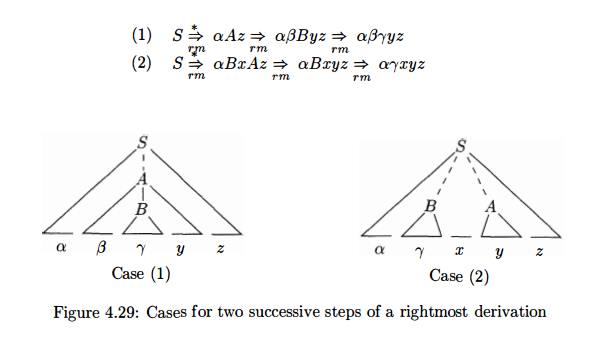
Consider case (1) in reverse, where a shift-reduce parser has just
reached the configuration

The
parser reduces the handle 7 to B to
reach the configuration

The parser can now shift the string y
onto the stack by a sequence of zero or more shift moves to reach the
configuration

with the handle bBy on top of
the stack, and it gets reduced to A.
Now consider case (2). In configuration

In both cases, after making a reduction the parser had to shift zero or
more symbols to get the next handle onto the stack. It never had to go into the
stack to find the handle.
4. Conflicts During Shift-Reduce
Parsing
There are context-free grammars for which shift-reduce parsing cannot be
used. Every shift-reduce parser for such a grammar can reach a configuration in
which the parser, knowing the entire stack contents and the next input symbol,
cannot decide whether to shift or to reduce (a shift/reduce conflict), or cannot decide which of several reductions
to make (a reduce/reduce
conflict). We now give some examples of syntactic constructs
that give rise to such grammars. Techni-cally, these grammars are not in the
LR(fc) class of grammars defined in Section 4.7; we refer to them as non-LR
grammars. The k in LR(k) refers to the number of symbols of lookahead on the
input. Grammars used in compiling usually fall in the LR(1) class, with one
symbol of lookahead at most.
Example 4 . 3 8 : An ambiguous grammar can never be LR. For example, con-sider the
dangling-else grammar (4.14) of Section 4.3:
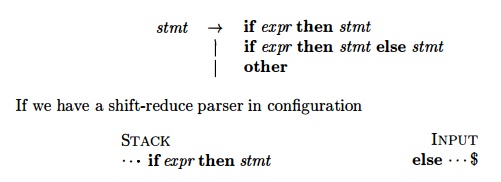
we cannot tell whether if expr t h e n stmt is the handle, no matter
what appears below it on the stack. Here
there is a shift/reduce conflict.
Depending on what follows the else on the input, it might be correct to
reduce if expr t h e n stmt to stmt, or it might be correct to shift else and
then to look for another stmt to complete the
alternative if expr t h e n stmt
else stmt.
Note that shift-reduce
parsing can be adapted to parse certain
ambiguous grammars, such as the if-then-else grammar above. If we
resolve the shift/reduce conflict on else in favor of shifting, the parser will
behave as we expect, associating each else with the previous unmatched then .
We discuss parsers for such ambiguous grammars in Section 4.8.
Another common setting for conflicts occurs when we know we have a
han-dle, but the stack contents and the next input symbol are insufficient to
de-termine which production should be used in a reduction. The next example
illustrates this situation.
Example 4.39 : Suppose we have a lexical analyzer that returns the token
name id for all names, regardless of their type. Suppose also that our
lan-guage invokes procedures by giving their names, with parameters surrounded
by parentheses, and that arrays are referenced by the same syntax. Since the
translation of indices in array references and parameters in procedure calls
are different, we want to use different productions to generate lists of actual
parameters and indices. Our grammar might therefore have (among others)
productions such as those in Fig. 4.30.
A statement beginning with p
( i , j ) would appear as
the token stream id(id, id) to the parser. After shifting the first three tokens onto
the stack, a shift-reduce parser would be in configuration
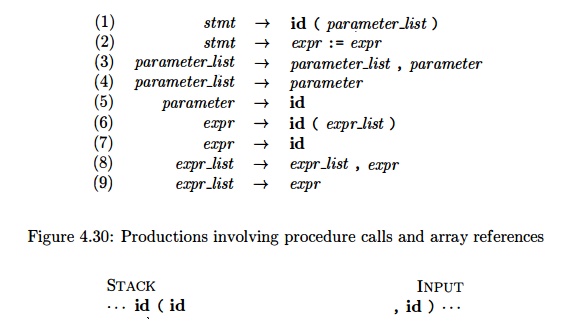
It is evident that the id on
top of the stack must be reduced, but by which production? The correct choice
is production (5) if p is a procedure, but pro-duction (7) if p is an array.
The stack does not tell which; information in the symbol table obtained from
the declaration of p must be used.
One solution is to change the token id
in production (1) to procid and to
use a more sophisticated lexical analyzer that returns the token name procid when it recognizes a lexeme that
is the name of a procedure. Doing so would require the lexical analyzer to
consult the symbol table before returning a token.
If we
made this modification, then on processing p ( i , j ) the parser would be either in the
configuration

or in the configuration above. In the former case, we choose reduction
by production (5); in the latter case by production (7). Notice how the symbol
third from the top of the stack determines the reduction to be made, even
though it is not involved in the reduction. Shift-reduce parsing can utilize
information far down in the stack to guide the parse.
5. Exercises for Section 4.5
Exercise 4.5.1 : For the grammar 5
- > 0 5 1 | 0 1 o f Exercise
4.2.2(a), indicate the handle in each of the following right-sentential forms:
a) 000111.
b) 00511 .
Exercise 4.5.2 : Repeat Exercise
4.5.1 for the grammar S -» 5 5 + | 5 5 *
| a of Exercise 4.2.1 and the following right-sentential forms:
SSS + a*+.
SS + a*a+.
aaa * a + +.
Exercise 4 . 5 . 3 : Give bottom-up parses for the following input strings and
grammars:
The input 000111 according to the
grammar of Exercise 4.5.1.
The input aaa * a + + according to the grammar of Exercise 4.5.2.
Related Topics